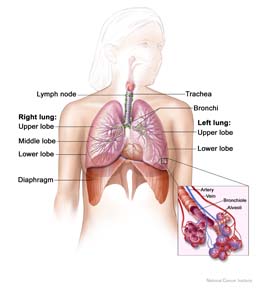Mesothelioma Defined
So what exactly is mesothelioma? A layer of mesothelial cells line the chest, heart and abdominal cavities. These cells, in turn, coat the outer surface of most internal organs. The tissue formed by these cells is called mesothelium. The mesothelium helps protect the organs by producing a special lubricating fluid that allows organs to move around. For example, this fluid makes it easier for the lungs to move inside the chest during breathing. The mesothelium of the chest is called the pleura and the mesothelium of the abdomen is known as the peritoneum. The mesothelium of the pericardial cavity (the "sac-like" space around the heart) is called the pericardium.
Mesothelioma has been recognized as a tumor of the pleura, peritoneum and pericardium since the late 1700s. However it was not until 1960 that this particular type of tumor was associated with asbestos exposure. The first report linking mesothelioma to asbestos exposure was written by J.C.Wagner, and described 32 cases of workers in the "Asbestos Hills" in South Africa. Since then, the relationship between mesothelioma and asbestos exposure has been confirmed in studies around the world. The incidence of mesothelioma in the United States remains very low, with 14 cases occurring per million people per year. Despite these numbers, the noticed threefold increase in mesothelioma in males between 1970 and 1984, is directly associated with environmental and occupational exposure to asbestos, mostly in areas of asbestos product plants and shipbuilding facilities. Although the disease is much more commonly seen in older males it has been diagnosed in women and early childhood as well. In those cases, scientists are at a loss to explain the occurrences because they are unlikely to have been exposed to asbestos for great periods of time. Malignant mesothelioma is divided into three main types. About 50% to 70% of mesothelioma occurrences are the epithelioid type. This type has the best prognosis (outlook for survival). The other two types are the sarcomatoid type (7%-20%), and the mixed/biphasic type (20%-35%). Treatment options for all three types are the same. About three-fourths of mesothelioma occurrences start in the chest cavity and is known as pleural mesothelioma. Another 10% to 20% begin in the abdomen and is called peritoneal mesothelioma. Pericardial mesothelioma, starting in the cavity around the heart, is very rare. The covering layer of the testicles is actually an outpouching of peritoneum into the scrotum. Mesothelioma that affects this covering of the testicles is quite rare. |
